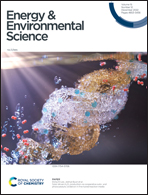An alloy small molecule acceptor for green printing organic solar cells overcoming the scaling lag of efficiency†
Abstract
How to design organic solar cell (OSC) systems with high device efficiency and excellent processing performance is still one of the urgent issues to be solved. Herein, we designed an asymmetric acceptor BTP-F3Cl and incorporated it into the PM1:L8-BO blend. Compared with the L8-BO neat acceptor, the L8-BO:BTP-F3Cl alloy acceptor shows larger exciton diffusion length, higher photoluminescence quantum yield and superior electron mobility. With the introduction of BTP-F3Cl, the red-shifted absorption spectra, the prolonged exciton lifetime, the enhanced charge transport property, and the depressed non-radiative recombination promote the ternary system to obtain improved short-circuit current density and fill factor. Consequently, the ternary device delivers an efficiency of 19.1% (certified as 18.7%), representing one of the highest values reported so far. Moreover, this system can achieve a promising efficiency of approximately 19% in tetrahydrofuran-processed OPV devices fabricated by a blade-coating technology. Importantly, the BTP-F3Cl-introduced ternary system can overcome the scaling lag of device efficiency more effectively than the host system. Overall, this work can effectively guide the lab-to-manufacturing translation of green printing OSCs.



 Please wait while we load your content...
Please wait while we load your content...